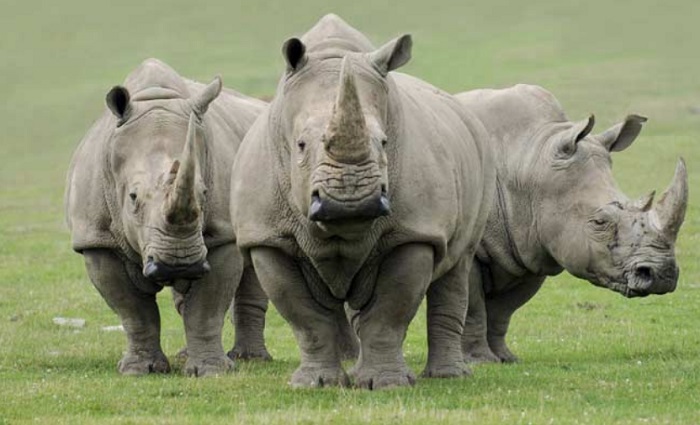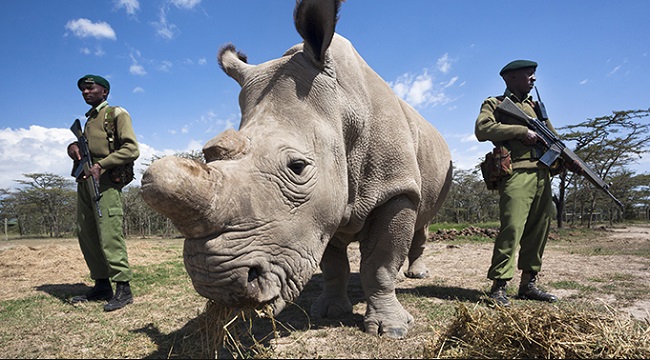
The last three Northern white rhinoceros live in a sanctuary in Ol Pejeta Conservancy in Kenya.
Did you know?
- There are only 3 Northern white rhinos left in the world. They live in a private sanctuary in Kenya.
- One of them is a male and two are female. Neither female is capable of natural reproduction.
- There are two subspecies of the White Rhino; the Northern white rhino which is critically endangered and extinct in the wild and the Southern white rhino which is near threatened and has healthy increasing populations.
Name
- Scientific Name: Ceratotherium simum cottoni
- Common Name: Northern white rhinoceros or Northern squared-lipped rhinoceros
Conservation Status
- The Northern white rhinoceros is considered “critically endangered” by the IUCN and is possibly extinct in the wild.
- The last 3 individuals were transferred from Dvur Kralove Zoo in the Czech Republic to Ol Pejeta Conservancy in Kenya, a sanctuary, where they are kept safe and in good health with around the clock security.
- Scientist are exploring the possibility of developing Northern White Rhino embryos and implant them into females Southern White Rhinos.
- African rhinos are protected by national and international initiatives such as the South African Development Community Rhino Management Group, East African Rhino Management Group, Southern African Rhino and Elephant Security Group/Interpol Environmental Crime Working Group,
- IUCN SSC African Rhino Specialist Group is the continental coordinating body for rhino conservation in Africa.
- Rhinos are protected by CITES Appendix I and II

Population
- As of 2017 there were only 3 individuals of this subspecies living at Ol Pejeta Conservancy in Kenya.
- The last known wild population lived in Garamba National Park in Kenya but they have not been spotted since 2007.
- Poaching Northern white rhinos for its horns is the reason the species has experienced a dramatic decrease in population. In the 1960s its wild population was estimated at 2000, by 2003 there were 30 and by 2007 its population was believed extinct in the wild.
Distribution
- Historically the Northern white rhino lived in northwestern Uganda, southern Chad, south-western Sudan, the eastern part of center African Republic, and northeastern part of the Democratic Republic of the Congo.
Habitat
- White rhinoceroses live within 25 km from water sources.
- During morning hours they are found in riverbanks as the temperature increases they move to shadier areas such as dense forests or mid-slopes of hills,
- They primarily inhabit grassy savanna and woodlands interspersed with grassy clearings and nutrient rich soils.

Northern white rhinos are guarded 24/7.
Physical Features
- White rhinoceros are not actually white. Their skin is pale gray, tough and on average 0.70 in (20 mm) thick.
- White rhinos are called “white” not because their skin is white but because their face is “wide”. Their name comes from the Afrikaans word “weit”, which means wide and refers to the animal’s muzzle.
- The difference between white and black rhinos is that black rhinos have a pointed upper lip while White Rhinos have a square upper lip. Their flat mouth is for grazing.
- Northern white rhinos are smaller and have sightly more hair covering their bodies than their southern cousins.
- They have two horns. The front horn averages 2 feet (0.6 m), but occasionally reaches 5 feet (1.5 m) in length.
- Females are slightly smaller than males in both subspecies.
- Average length not including tail is 11 to 12.4 feet (3.35 to 3.77 m.) Average tail length is 1.9 to 2.5 feet (0.57 to 0.77 m).
- White rhinoceros are one of the heaviest animals on earth they can weight from 2203 to 7930 lb (1000 to 3600 kg).
Behavior
- These mammals are herbivores and are the only grazers among the five rhino species, feeding almost exclusively on short grasses.
- When escaping from predators rhinoceros can run at speeds of 15 mph (24 km/hr) and can reach up to 25 mph (40 km/hr) for short periods.
- They are non aggressive animals. Females protecting their calves can get aggressive if they sense danger.
- During summer time white rhinos take mud baths to cool their skin.
- Hours of activity depends on the season. During summer they are crepuscular meaning that they are more active between 5 am to 9 am and 3 pm to 6:30 pm to avoid the heat. During winter they are diurnal with more active hours during daytime.
- White rhinos do not migrate. They are territorial and mark their boundaries with urine.
Reproduction
- White rhinoceros are polygynandrous, males and females have multiple mating partners. Females enter the male’s territory to mate.
- Females reach sexual maturity when they are 3 to 5 years old, while males at 5 to 7.
- They breed throughout the year with peeks between October to December. The breeding interval is from 2 to 3 years.
- The longer breeding interval is due to the long gestational period which is from 530 to 550 days.
- White rhinoceros give birth to one calf at a time.
Life expectancy
- The lifespan of white rhinoceroses differs between captivity and in the wild.
- The average lifespan of both males and females in the wild is 46 to 50 years.
- The recorded longest lifespan of northern white rhinoceroses in captivity is 30 years and 3 months.
Taxonomy
- Kingdom: Animalia
- Phylum: Chordata
- Class: Mammalia
- Order: Perissodactyla
- Family: Phinocerotidae
- Genus: Ceratothenium
- Species: C. simum
- Subspecies: C.s. cottoni
References and further research
- University of Michigan, Museum of Zoology – Ceratotherium simum white rhinoceros
- South African Development Community Rhino Management Group
- CITES Appendix I and II
- Southern African Rhino and Elephant Security Group/Interpol Environmental Crime Working Group
- IUCN SSC African Rhino Specialist Group
- Ol Pejeta Conservancy – North White Rhinos
- IUCN – Ceratotherium simum ssp. cottoni
- IUCN – Ceratotherium simum
- Dvur Kralove Zoo